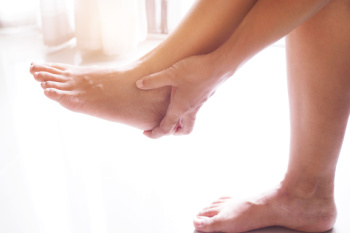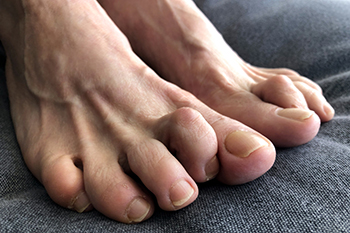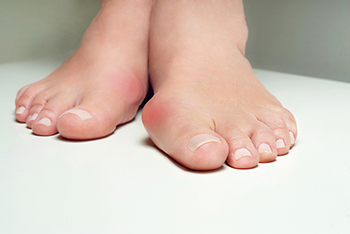Connect With Us
Blog

Basketball puts intense stress on the ankles due to frequent jumping, cutting, and sudden direction changes. Sprains are the most common injury, occurring when the ligaments overstretch or tear from awkward landings or collisions. High ankle sprains and fractures can also result from forceful twists or falls. Weak ankles, wearing improper footwear, and lack of conditioning increase the risk of injury. Strengthening exercises, balance training, and wearing supportive basketball shoes with proper ankle stability help prevent issues. Taping or bracing provides additional protection for players with a history of injuries. Immediate treatment includes rest, compression, and elevation to reduce swelling and pain. Ignoring an ankle injury can lead to chronic instability and long-term problems. If you have an ankle injury from playing basketball, it is suggested that you see a podiatrist for a proper diagnosis and customized treatment to promote healing and prevent re-injury.
Sports related foot and ankle injuries require proper treatment before players can go back to their regular routines. For more information, contact Dr. James D. McAlexander of Gig Harbor Foot and Ankle Clinic. Our doctor can provide the care you need to keep you pain-free and on your feet.
Sports Related Foot and Ankle Injuries
Foot and ankle injuries are a common occurrence when it comes to athletes of any sport. While many athletes dismiss the initial aches and pains, the truth is that ignoring potential foot and ankle injuries can lead to serious problems. As athletes continue to place pressure and strain the area further, a mild injury can turn into something as serious as a rupture and may lead to a permanent disability. There are many factors that contribute to sports related foot and ankle injuries, which include failure to warm up properly, not providing support or wearing bad footwear. Common injuries and conditions athletes face, including:
- Plantar Fasciitis
- Plantar Fasciosis
- Achilles Tendinitis
- Achilles Tendon Rupture
- Ankle Sprains
Sports related injuries are commonly treated using the RICE method. This includes rest, applying ice to the injured area, compression and elevating the ankle. More serious sprains and injuries may require surgery, which could include arthroscopic and reconstructive surgery. Rehabilitation and therapy may also be required in order to get any recovering athlete to become fully functional again. Any unusual aches and pains an athlete sustains must be evaluated by a licensed, reputable medical professional.
If you have any questions please feel free to contact our office located in Gig Harbor, WA . We offer the newest diagnostic and treatment technologies for all your foot and ankle needs.

Nerve damage following an ankle sprain can cause a variety of symptoms that may persist beyond the initial injury. Radiating pain is a common sign, often extending from the ankle into the foot or lower leg. This discomfort may feel sharp, burning, or tingling. Altered skin sensation, such as numbness, heightened sensitivity, or a pins and needles feeling, can also occur. In more severe cases, foot drop may develop, making it difficult to lift the front part of the foot while walking. Over time, a loss of muscle size can become noticeable due to reduced nerve function and weakened movement. If you have sprained your ankle, and are experiencing any of the above symptoms, it is suggested that you consult a podiatrist who can offer effective treatment solutions.
Ankle sprains are common but need immediate attention. If you need your feet checked, contact Dr. James D. McAlexander from Gig Harbor Foot and Ankle Clinic. Our doctor can provide the care you need to keep you pain-free and on your feet.
How Does an Ankle Sprain Occur?
Ankle sprains take place when the ligaments in your ankle are torn or stretched beyond their limits. There are multiple ways that the ankle can become injured, including twisting or rolling over onto your ankle, putting undue stress on it, or causing trauma to the ankle itself.
What Are the Symptoms?
- Mild to moderate bruising
- Limited mobility
- Swelling
- Discoloration of the skin (depending on severity)
Preventing a Sprain
- Wearing appropriate shoes for the occasion
- Stretching before exercises and sports
- Knowing your limits
Treatment of a Sprain
Treatment of a sprain depends on the severity. Many times, people are told to rest and remain off their feet completely, while others are given an air cast. If the sprain is very severe, surgery may be required.
If you have suffered an ankle sprain previously, you may want to consider additional support such as a brace and regular exercises to strengthen the ankle.
If you have any questions please feel free to contact our office located in Gig Harbor, WA . We offer the newest diagnostic and treatment technologies for all your foot and ankle needs.

Toenail fungus is a condition that causes nails to become discolored, thickened, or even crumble. The infection typically starts as a small white or yellow spot under the tip of the nail and can spread, leading to a more severe appearance. As the fungus progresses, nails may become brittle, cracked, or distorted, often causing discomfort or pain. The affected area might also have a foul odor. The primary cause of toenail fungus is exposure to warm, moist environments, such as public showers or tight-fitting shoes. Poor circulation, a weakened immune system, and injury to the nail can increase the risk. A podiatrist can diagnose toenail fungus and recommend antifungal medications, laser therapy, or specialized topical treatments to eliminate the infection. In severe cases, they may suggest nail removal. If you have developed toenail fungus, it is suggested that you schedule an appointment with a podiatrist for proper diagnosis and effective treatment.
If left untreated, toenail fungus may spread to other toenails, skin, or even fingernails. If you suspect you have toenail fungus it is important to seek treatment right away. For more information about treatment, contact Dr. James D. McAlexander of Gig Harbor Foot and Ankle Clinic. Our doctor can provide the care you need to keep you pain-free and on your feet.
Symptoms
- Warped or oddly shaped nails
- Yellowish nails
- Loose/separated nail
- Buildup of bits and pieces of nail fragments under the nail
- Brittle, broken, thickened nail
Treatment
If self-care strategies and over-the-counter medications does not help your fungus, your podiatrist may give you a prescription drug instead. Even if you find relief from your toenail fungus symptoms, you may experience a repeat infection in the future.
Prevention
In order to prevent getting toenail fungus in the future, you should always make sure to wash your feet with soap and water. After washing, it is important to dry your feet thoroughly especially in between the toes. When trimming your toenails, be sure to trim straight across instead of in a rounded shape. It is crucial not to cover up discolored nails with nail polish because that will prevent your nail from being able to “breathe”.
In some cases, surgical procedure may be needed to remove the toenail fungus. Consult with your podiatrist about the best treatment options for your case of toenail fungus.
If you have any questions, please feel free to contact our office located in Gig Harbor, WA . We offer the newest diagnostic and treatment technologies for all your foot care needs.

Plantar fasciitis is a common cause of heel pain, and while treatment often involves specific stretches and wearing proper footwear, certain vitamins and supplements can help manage symptoms and promote healing. Bromelain, an enzyme found in pineapple, is known for its anti-inflammatory properties and can reduce swelling and pain associated with plantar fasciitis. Vitamin C is essential for collagen production and tissue repair, supporting the healing of the plantar fascia. Vitamin B5, or pantothenic acid, helps in the regeneration of damaged tissues and reduces inflammation. Magnesium plays a role in muscle function and can help alleviate tightness in the calf muscles, which can contribute to plantar fasciitis pain. Turmeric, with its active compound curcumin, is another powerful anti-inflammatory that can help reduce pain and swelling in the affected area. When used alongside other treatments, these vitamins and supplements may provide additional relief and support recovery from plantar fasciitis. If you have plantar fasciitis, it is suggested that you schedule an appointment with a podiatrist.
Plantar fasciitis can be very painful and inconvenient. If you are experiencing heel pain or symptoms of plantar fasciitis, contact Dr. James D. McAlexander from Gig Harbor Foot and Ankle Clinic. Our doctor can provide the care you need to keep you pain-free and on your feet.
What Is Plantar Fasciitis?
Plantar fasciitis is the inflammation of the thick band of tissue that runs along the bottom of your foot, known as the plantar fascia, and causes mild to severe heel pain.
What Causes Plantar Fasciitis?
- Excessive running
- Non-supportive shoes
- Overpronation
- Repeated stretching and tearing of the plantar fascia
How Can It Be Treated?
- Conservative measures – anti-inflammatories, ice packs, stretching exercises, physical therapy, orthotic devices
- Shockwave therapy – sound waves are sent to the affected area to facilitate healing and are usually used for chronic cases of plantar fasciitis
- Surgery – usually only used as a last resort when all else fails. The plantar fascia can be surgically detached from the heel
While very treatable, plantar fasciitis is definitely not something that should be ignored. Especially in severe cases, speaking to your doctor right away is highly recommended to avoid complications and severe heel pain. Your podiatrist can work with you to provide the appropriate treatment options tailored to your condition.
If you have any questions please feel free to contact our office located in Gig Harbor, WA . We offer the newest diagnostic and treatment technologies for all your foot and ankle needs.

Hammertoe is a deformity where the middle joint of a toe bends downward, resembling a hammer. It often develops due to wearing tight or narrow shoes that force the toes into a bent position. Other causes include muscle imbalances, trauma, arthritis, or genetic predisposition. Conditions like diabetes may also contribute by affecting nerve and muscle function. Symptoms of hammertoe include pain, stiffness, swelling in the affected toe, difficulty straightening it, and the development of corns or calluses from friction against footwear. Over time, the toe may become rigid, limiting movement and causing discomfort during walking or standing. Diagnosis involves a podiatrist examining the toe’s flexibility and alignment. X-rays may be used to assess bone and joint changes. If you think you have a hammertoe, it is suggested that you consult a podiatrist to ensure an accurate diagnosis and a tailored treatment to relieve pain, restore function, and prevent complications.
Hammertoes can be a painful condition to live with. For more information, contact Dr. James D. McAlexander of Gig Harbor Foot and Ankle Clinic. Our doctor will answer any of your foot- and ankle-related questions.
Hammertoe
Hammertoe is a foot deformity that occurs due to an imbalance in the muscles, tendons, or ligaments that normally hold the toe straight. It can be caused by the type of shoes you wear, your foot structure, trauma, and certain disease processes.
Symptoms
- Painful and/or difficult toe movement
- Swelling
- Joint stiffness
- Calluses/Corns
- Physical deformity
Risk Factors
- Age – The risk of hammertoe increases with age
- Sex – Women are more likely to have hammertoe compared to men
- Toe Length – You are more likely to develop hammertoe if your second toe is longer than your big toe
- Certain Diseases – Arthritis and diabetes may make you more likely to develop hammertoe
Treatment
If you have hammertoe, you should change into a more comfortable shoe that provides enough room for your toes. Exercises such as picking up marbles may strengthen and stretch your toe muscles. Nevertheless, it is important to seek assistance from a podiatrist in order to determine the severity of your hammertoe and see which treatment option will work best for you.
If you have any questions, please feel free to contact our office located in Gig Harbor, WA . We offer the newest diagnostic and treatment technologies for all your foot care needs.

A bunion is a bony bump that forms at the base of the big toe, caused by the tip of the toe leaning toward the second toe. This condition often results in pain, swelling, and redness surrounding the joint. Over time, bunions can make walking or wearing shoes uncomfortable, especially if the bump rubs against the inside of the shoe. The main cause of bunions is genetics, but they can also develop due to wearing tight or ill-fitting shoes, arthritis, or abnormal foot mechanics. The pressure on the big toe joint leads to misalignment and the growth of the bony bump. Treatment options for bunions include wearing wider shoes, using bunion pads, and doing foot exercises to improve flexibility. In more severe cases, a podiatrist might recommend custom orthotics or even surgery to correct the deformity. If you have developed a bunion, it is suggested that you schedule an appointment with a podiatrist.
If you are suffering from bunion pain, contact Dr. James D. McAlexander of Gig Harbor Foot and Ankle Clinic. Our doctor can provide the care you need to keep you pain-free and on your feet.
What Is a Bunion?
Bunions are painful bony bumps that usually develop on the inside of the foot at the joint of the big toe. As the deformity increases over time, it may become painful to walk and wear shoes. Women are more likely to exacerbate existing bunions since they often wear tight, narrow shoes that shift their toes together. Bunion pain can be relieved by wearing wider shoes with enough room for the toes.
Causes
- Genetics – some people inherit feet that are more prone to bunion development
- Inflammatory Conditions - rheumatoid arthritis and polio may cause bunion development
Symptoms
- Redness and inflammation
- Pain and tenderness
- Callus or corns on the bump
- Restricted motion in the big toe
In order to diagnose your bunion, your podiatrist may ask about your medical history, symptoms, and general health. Your doctor might also order an x-ray to take a closer look at your feet. Nonsurgical treatment options include orthotics, padding, icing, changes in footwear, and medication. If nonsurgical treatments don’t alleviate your bunion pain, surgery may be necessary.
If you have any questions, please feel free to contact our office located in Gig Harbor, WA . We offer the newest diagnostic and treatment technologies for all your foot care needs.
Blog Archives
- March 2025
- February 2025
- January 2025
- December 2024
- November 2024
- October 2024
- September 2024
- April 2023
- March 2023
- February 2023
- January 2023
- December 2022
- November 2022
- October 2022
- September 2022
- August 2022
- July 2022
- June 2022
- May 2022
- April 2022
- March 2022
- February 2022
- January 2022
- December 2021
- November 2021
- October 2021
- September 2021
- August 2021
- July 2021
- June 2021
- May 2021
- April 2021
- March 2021
- February 2021
- January 2021
- December 2020
- November 2020
- October 2020
- September 2020
- August 2020
- July 2020
- June 2020
- May 2020
- April 2020
- March 2020
- February 2020
- January 2020
- December 2019
- November 2019
- October 2019
- September 2019
- August 2019
- July 2019
- June 2019
- May 2019
- April 2019
- March 2019
- February 2019
- January 2019
- December 2018
- November 2018
- October 2018
- September 2018
- August 2018
- July 2018
- June 2018
- May 2018
- April 2018
- March 2018
- February 2018
- January 2018
- December 2017
- November 2017
- October 2017


